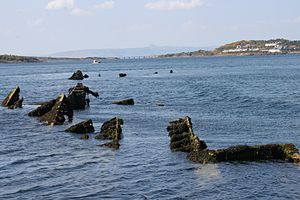Northern Barrage
1939 1940 1941 1942 1943 1944 1945 The Northern Barrage was the name given to minefields laid by the British during World War II to restrict German access to the Atlantic Ocean.[1] Conventional mines of the era employed a contact-fuzed explosive charge within a buoyant shell suspended over an anchor attached by a wire rope.The Royal Navy standard Mk XVII mine inventory available for use at the outbreak of World War II lacked an antenna fuze.[3] Those depth capabilities suggested the possibility of laying mines along the Iceland–Faeroes Ridge, a submerged mountain range between Iceland and the Faeroe Islands which separates the deeper portions of the Norwegian Sea to the north and the Atlantic Ocean to the south.Laying the Northern Barrage in waters so far from land was a challenging navigational problem before Global Positioning System information was available.[4] The first Minelaying Squadron, based at Kyle of Lochalsh (code-named port ZA for secrecy), was formed in June 1940.Intelligence reports in July indicated that U-boats were using the Faeroes–Iceland passage, so a series of deep anti-submarine fields were laid north-west of the Faeroes.[1] In fog on 5 July 1942 HMS Niger mistook an iceberg for Iceland’s North Western Cape and led six merchant ships of Murmansk to Reykjavík convoy QP 13 into minefield SN72 laid one month earlier at the entrance to the Denmark Strait.



North Sea Mine BarrageAtlantic campaignAmericasUnited StatesCaribbeanSt. LawrenceBlockade of GermanyGibraltarRiver Plate1st Happy TimeNordseetourBerlinHX 106OB 293HX 1124 AprilOB 318HX 126RheinübungDenmark StraitBismarckHX 133HX 156Postmaster2nd Happy TimeTorpedo AlleyNeuland27 MarchConnecticut6 JuneON 113ON 115ON 122Bell IslandON 127LaconiaSC 100SG 6/LN 6SC 104HX 212SL 125SC 107ON 144ON 153ON 154SC 118ON 166SC 121HX 228HX 229/SC 122HX 231Black MayHX 237SC 129SC 130ONS 18/ON 202SC 143ONS 20/ON 206Sept-ÎlesON 207SL 138/MKS 28SL 139/MKS 30SL 140/MKS 31StonewallBay of BiscayLyme Bay26 April 1944HX 300BX 141TeardropPoint Judith5–6 May 19457–8 May 1945Southern PrinceflagshipHMS ScottWorld War IIOrkneyFaroe IslandsIcelandOrkney IslandsNorwayWorld War Ioccupation of NorwaycopperbatteryNorwegian SeaGreenlandnavigational aidsnavigationalGlobal Positioning Systemsurvey vesselKyle of Lochalshcargo linersHMS AgamemnonMenestheusPort NapierPort QuebecTown-class destroyersDestroyers for Bases AgreementHMS AdventureFaeroesNorth RonaHMS KenyaSula SgeirHMS Teviot BankButt of LewisHMS WelshmanHMS NigerMurmanskReykjavíkconvoy QP 13PanamanianNaval Armed GuardsLiberty shipHMS Port NapierAdmiraltyHome Fleetcorrodedammonium nitrateAmatolaluminum